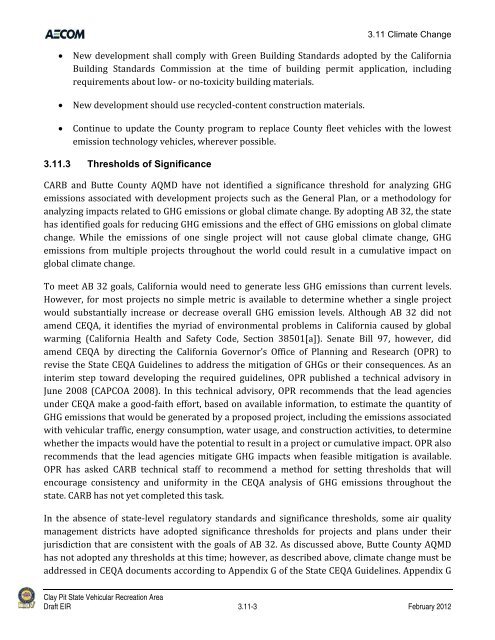Draft Environmental Impact Report - California Off Highway Vehicle ...
Draft Environmental Impact Report - California Off Highway Vehicle ...
Draft Environmental Impact Report - California Off Highway Vehicle ...
You also want an ePaper? Increase the reach of your titles
YUMPU automatically turns print PDFs into web optimized ePapers that Google loves.
3.11 Climate Change<br />
New development shall comply with Green Building Standards adopted by the <strong>California</strong><br />
Building Standards Commission at the time of building permit application, including<br />
requirements about low‐ or no‐toxicity building materials.<br />
New development should use recycled‐content construction materials.<br />
Continue to update the County program to replace County fleet vehicles with the lowest<br />
emission technology vehicles, wherever possible.<br />
3.11.3 Thresholds of Significance<br />
CARB and Butte County AQMD have not identified a significance threshold for analyzing GHG<br />
emissions associated with development projects such as the General Plan, or a methodology for<br />
analyzing impacts related to GHG emissions or global climate change. By adopting AB 32, the state<br />
has identified goals for reducing GHG emissions and the effect of GHG emissions on global climate<br />
change. While the emissions of one single project will not cause global climate change, GHG<br />
emissions from multiple projects throughout the world could result in a cumulative impact on<br />
global climate change.<br />
To meet AB 32 goals, <strong>California</strong> would need to generate less GHG emissions than current levels.<br />
However, for most projects no simple metric is available to determine whether a single project<br />
would substantially increase or decrease overall GHG emission levels. Although AB 32 did not<br />
amend CEQA, it identifies the myriad of environmental problems in <strong>California</strong> caused by global<br />
warming (<strong>California</strong> Health and Safety Code, Section 38501[a]). Senate Bill 97, however, did<br />
amend CEQA by directing the <strong>California</strong> Governor’s <strong>Off</strong>ice of Planning and Research (OPR) to<br />
revise the State CEQA Guidelines to address the mitigation of GHGs or their consequences. As an<br />
interim step toward developing the required guidelines, OPR published a technical advisory in<br />
June 2008 (CAPCOA 2008). In this technical advisory, OPR recommends that the lead agencies<br />
under CEQA make a good‐faith effort, based on available information, to estimate the quantity of<br />
GHG emissions that would be generated by a proposed project, including the emissions associated<br />
with vehicular traffic, energy consumption, water usage, and construction activities, to determine<br />
whether the impacts would have the potential to result in a project or cumulative impact. OPR also<br />
recommends that the lead agencies mitigate GHG impacts when feasible mitigation is available.<br />
OPR has asked CARB technical staff to recommend a method for setting thresholds that will<br />
encourage consistency and uniformity in the CEQA analysis of GHG emissions throughout the<br />
state. CARB has not yet completed this task.<br />
In the absence of state‐level regulatory standards and significance thresholds, some air quality<br />
management districts have adopted significance thresholds for projects and plans under their<br />
jurisdiction that are consistent with the goals of AB 32. As discussed above, Butte County AQMD<br />
has not adopted any thresholds at this time; however, as described above, climate change must be<br />
addressed in CEQA documents according to Appendix G of the State CEQA Guidelines. Appendix G<br />
Clay Pit State Vehicular Recreation Area<br />
<strong>Draft</strong> EIR 3.11-3 February 2012








